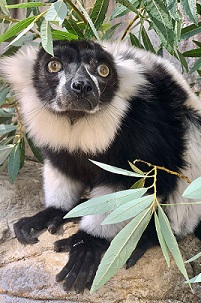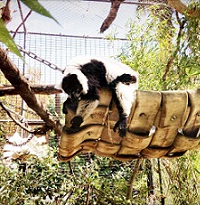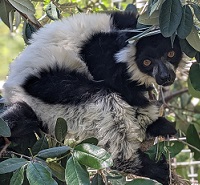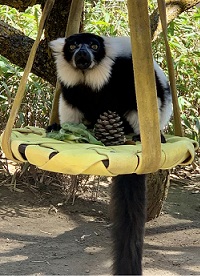Micke Grove Zoo
SJGOV.org - How can we serve you today?
Black-and-White Ruffed Lemur
Varecia variegata
- Habitat: Coastal tropical rainforest
- Range: Eastern Madagascar
- Natural Diet: Fruits, leaves, flowers, seeds, nectar
- Status in the Wild: THREATENED
All
about Black and White Ruffed Lemurs
Lemurs are closely related to other primates such as monkeys and
apes and are only found in Madagascar. The Ruffed Lemurs (black and
white, and red) are similar in size and behavior. Like the other
Ruffed Lemurs, the Black and White Ruffed Lemurs are medium in size
but have a fascinating color distribution. Their underbellies,
shoulder, neck, face, tails, and the inner side of their hands and
legs are black while the rest of their bodies and the crown of their
heads are white. Like the Red Ruffed Lemurs, their tails are usually
2 feet long and are longer than their bodies. They have long bodies
and legs and slender snouts. Males and females are monomorphic and
are both around 6 to 8 pounds. Lemurs are arboreal creatures, and
are active during the day (diurnal), spending most of their time
living and resting in trees. Their body colors help camouflage them
from predators.
Diet/ Habitat/
Range
Black and White Ruffed Lemurs are endemic to Madagascar. They live in the thickly vegetated tropical rainforests of Eastern Madagascar. These lemurs occupy a greater distributional range than the Red Ruffed lemurs stretching from the Masoala Peninsula through the Andasibe-Mantadia National Park all the way to the south of the Mananara River.
Ruffed Lemurs (both black and white, and red) feed on fruits,
insects, flowers, seeds, nectar, and pollen. A considerable
proportion (75% or more) of their diet is filled with fruits
(frugivorous). Nectar is a very popular seasonal food resource that
Ruffed Lemurs feast on. Since pollen that is rubbed onto their fur
is carried to other flowers, these lemurs are also categorized as
pollinators.
Behavior
Ruffed Lemurs are highly social and live in large family groups (15 or more lemurs) in the wild consisting of several males and females. In their family groups, females fill positions of dominance and power (matriarchal). In large family groups, each lemur occupies a position of power in a hierarchical system. These positions are maintained through grooming privileges where subordinate lemurs groom dominant individuals. Dominant lemurs experience several privileges such as primary to food resources, primary rights to breed, and access to partners.
They emit several different types of calls for specific purposes. Some of these calls are very loud, especially those made to let neighboring lemur groups know that this territory is occupied. Another vocalization that is most commonly heard is an alarm call that is emitted to warn members of their group to watch out for predators that may be close by. They also emit calls. Red Ruffed Lemurs maintain territories to protect their food resources and resting grounds. They scent-mark the territorial boundaries with urine.
Reproduction
Breeding seasons last during the summer months. The males usually initiate the reproductive behavioral sequence by vocalizing with “woos” and scent marking. The gestation period is 3.5 months long and two to three young are born.
Both males and females take care of their young (biparental care).
Females build a nest in which the infants are placed until they
wean. Young wean at 4 months of age. Since a considerable proportion
of behavior in their behavioral repertoire is gained through
learning, parents train
their young to find the right food items to eat, maintain
territories to protect their feeding and resting areas, stay alert
for predators, and take care of their young.
Conservation/Status
The most
significant threat to the wild populations of Black and White Lemurs
is the loss of their natural habitat mainly due to slash-and-burn
agricultural practices, logging, and mining. These threats have led
to the severe fragmentation of their habitat isolating wild
populations in fragmented pockets leading to inbreeding and higher
levels of disease incidence. Illegal hunting and trapping, currently
prevalent have also had a detrimental effect on their numbers in the
wild. Since Black and White Lemurs are only found in Madagascar, the
International Union for the Conservation of Nature has categorized
them as
CRITICALLY ENDANGERED.

Their black and white color helps them camouflage from predators in their natural habitat

They are provided with elevated hammocks made of fire-hose that they often use
.jpg)
Distributional range - they are endemic to Madagascar
Allogrooming is commonly seen in black and white ruffed lemurs

Several bushes and artificial sleeping and resting platforms are in their zoo habitat that provide them with structures to climb
